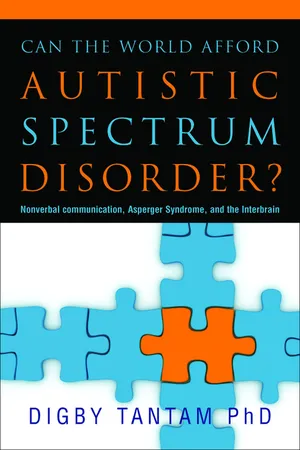Psychology
Non Verbal Communication
Nonverbal communication refers to the transmission of messages or signals through non-linguistic means such as facial expressions, body language, gestures, and tone of voice. It plays a crucial role in conveying emotions, attitudes, and intentions, often complementing or contradicting verbal communication. Nonverbal cues can significantly impact interpersonal relationships, social interactions, and overall understanding of communication.
Written by Perlego with AI-assistance
Related key terms
Related key terms
1 of 4
Related key terms
1 of 3
12 Key excerpts on "Non Verbal Communication"
- Jane Jackson(Author)
- 2019(Publication Date)
- Routledge(Publisher)
Therefore, Knapp et al. (2014) argue that nonverbal communication should be regarded as ‘an inseparable part of the total communication process’ (p. 28). As individuals transmit and receive messages, nonverbal codes often interact with verbal forms of communication (e.g., the use of sounds and words). For example, gestures (movements of part of the body to express an idea or meaning) and facial expressions (facial motions that convey one’s emotional or affective state) may accompany words. Speech may also vary with regard to such aspects as accent, rate, tone, and volume, all of which are considered nonverbal features. To complicate matters, verbal and nonverbal codes may communicate meaning together or separately, as Hickson et al. (2004: 9) explain: Nonverbal communication is complex because it creates communication by use of nonverbal behaviors, either by themselves or combined with words. It may be shared between people (interpersonally) or within a person (intrapersonally). It may be intentional or unintentional. It may also be used without words, or it may take on meaning only when it is used in combination with words. (emphasis in the original) Both verbal and nonverbal channels of communication consist of symbols and patterns that are learned over time. Just as different societies and cultures may have different languages or dialects, some of their nonverbal codes and norms of behavior (e.g., accepted patterns or rules) may vary across cultures and differ depending on the context and situation. Through enculturation, the primary socialization process, individuals develop the ability to appropriately use and interpret verbal and nonverbal cues in particular cultural contexts. As children mature they acquire their first language (and perhaps others), that is, they learn the meanings of words and expressions along with rules of verbal communication (e.g., the politeness norms of speech, cultural scripts for greetings/requests/refusals)- eBook - ePub
Interpersonal Communication
Competence and Contexts
- Shelley D. Lane(Author)
- 2016(Publication Date)
- Routledge(Publisher)
Nonverbal communication refers to all forms of communication other than words themselves. This form of communication occurs via gestures, body orientation and posture, touch, facial expression and eye contact, vocal qualities and accents, body shape, clothing and artifacts (such as jewelry and tattoos), the environment in which both verbal and nonverbal communication takes place, and how close or far away we sit or stand from others. Even time is a form of nonverbal communication. Nonverbal behavior is an integral part of the overall study of communication because it is a significant channel for creating and sharing meaning.Even though nonverbal communication is an important channel of meaning, the interpretation of nonverbal behavior isn’t always straightforward because nonverbal communication is ambiguous. One reason that accounts for such ambiguity is that nonverbal behaviors can have various meanings. Consider the various meanings associated with a pat on the back. It can be interpreted as an expression of sympathy (“I’m so sorry”), encouragement (“Way to go!”), or merely an attempt to engage our attention (“Hey!”). The influence of contexts also affects how we interpret nonverbal communication. For example, Navajo children are typically taught that it is impolite to make prolonged eye contact with others. However, lack of eye contact is considered disrespectful in the dominant U.S. culture.3 Nonverbal communication can also be ambiguous because nonverbal behavior may be intentional or unintentional. For example, although we may not consciously and intentionally end our sentences with a rising inflection (sometimes labeled “up-talk”), we may be perceived as insecure or immature on the basis of this nonverbal behavior. Because nonverbal communication is ambiguous, it’s best to interpret nonverbal behavior in conjunction with verbal communication.Nonverbal communication can have many meanings and can influence our behavior.Source: © 1992 Paws, Inc. Reprinted with permission of UNIVERSAL PRESS SYNDICATE. All Rights Reserved. - eBook - ePub
Messages
An Introduction to Communication
- Arthur Asa Berger(Author)
- 2016(Publication Date)
- Routledge(Publisher)
Chapter9 Nonverbal and Visual CommunicationAlthough “language” often comes to mind when considering communication, no discussion of communication is complete without the inclusion of nonverbal communication. Nonverbal communication has been referred to as “body language” in popular culture since the publication of Julius Fast’s book of the same name in 1970. Researchers, however, have defined nonverbal communication as encompassing almost all of human communication except the spoken and written word…. We also define nonverbal communication as the transfer and exchange of messages in any and all modalities that do not include words . As we discuss shortly, one of the major ways by which nonverbal communication occurs is through nonverbal behaviors , which are behaviors that occur during communication that do not include verbal language. But our definition of nonverbal communication implies that it is more than body language. It can be the distance people stand apart when they converse. It can be the sweat stains in their armpits. It can be the design of the room. Nonverbal communication is a broader category than nonverbal behavior, encompassing the way you dress, the place of your office within a larger building, the use of time, the bumper stickers you place on your car, or the arrangement, lighting, or color of your room.David Matsumoto, Mark G. Frame, Hyi Sung Hwang, eds., Nonverbal Communication: Science and ApplicationsIn this chapter I will deal with two aspects of communication: first I will consider the way individuals communicate with others nonverbally, and then I will discuss images and their role in the communication process. I will consider images in dreams and the functions of images in advertising, religion, politics, and personal identity. - eBook - ePub
- Bruce M. Rowe, Diane P. Levine(Authors)
- 2022(Publication Date)
- Routledge(Publisher)
Today, the study of nonverbal communication is a dynamic and expanding field. There is an abundance of articles and papers being published each month in popular magazines and professional journals, as well as a growing number of mass-market and specialized books. There was even a US television program, Lie to Me (originally broadcast 2009–2011), about the usefulness of the analysis of nonverbal cues in criminal investigations. 1 Charles Darwin, The Expression of the Emotions in Man and Animals (London: John Murray, 1872). This has been reprinted numerous times (and in several languages), most recently in 2016. What does “nonverbal” mean? A police officer stops a motorist for allegedly speeding. Taking a firm stance very close to the motorist’s car door while maintaining a forbidding gaze, the officer says, “May I see your license?” Fidgeting through his wallet, brows lowered and drawn together, eyes bulging, nostrils dilated, the motorist responds in a sheepish voice, “What did I do wrong?” Not receiving an immediate answer, the motorist begins nervously patting his leg. Only some of the messages being conveyed in this interchange depend on words. All the other messages are conveyed nonverbally. Nonverbal communication is any communication that occurs between people, usually within each other’s presence, by means other than spoken or written words or the signs (words) of a sign language. The firm stance, stern gaze, and the “invasion” of the motorist’s territory may have conveyed the idea of the officer’s authority and dominance. The motorist’s fidgeting, patting himself, and his facial expression may have delivered the message of his nervousness, restlessness, or anger. Nonverbal behavior is important in establishing, regulating, and maintaining interpersonal relationships. Although there are other forms of nonverbal behavior, we will explore the form and function of only eight types in this chapter - eBook - ePub
Applied Organizational Communication
Theory and Practice in a Global Environment
- Thomas E. Harris, Mark D. Nelson(Authors)
- 2018(Publication Date)
- Routledge(Publisher)
5 Nonverbal Communication Key concepts in this chapter include:Overview• Verbal vs. nonverbal communication• Principles of nonverbal communication• High-context and low-context cultures• Facial display• Eye contact• Paralanguage• Body language• Clothing• Proxemics“Actions speak louder than words,” “People believe what you do more than what you say,” and “You should walk the talk” are familiar admonitions. Nonverbal messages can convey affiliation, positive regard, interest, dominance, credibility, or status. In addition, they can reinforce or punish; affect what others learn; what attitudes develop; what approaches will be modeled; and what is expected. We continuously send and receive wordless signals. Even when you are not speaking, you are still communicating nonverbally. Nonverbal communication includes nuances of voice, details of dress, choice and movement of objects that communicate, time, space, body movements, facial expressions, and body orientation.Nonverbal communication principles have wide organizational applications (Bonaccio et al., 2016). Topics range from helping managers and leaders increase their effectiveness, to improving office design, to understanding organizational cultures. International communication success can hinge on culturally appropriate nonverbal actions and our increasing need to be able to work in diverse groups requires an appreciation for differences in nonverbal expectations and behaviors. Nonverbal communication has important consequences when organizations try to flatten the organization and treat everyone as equals. Traditionally, nonverbal communication announces and reinforces the differences in status that exist between members of an organization. Most organizations go to great lengths to create the desired impression on visitors, clients, and employees through office and building design. - eBook - ePub
- Richard Gross, Rob McIlveen(Authors)
- 2016(Publication Date)
- Routledge(Publisher)
6 Non-verbal communication and interpersonal behaviour• Introduction • Animal communication • Non-verbal behaviour • Gender and cultural issues relating to non-verbal behaviour • Functions of non-verbal behaviour • Interaction of verbal and non-verbal behaviours in conversation • Verbal communication and questioning • Application: health professional–client interaction • Summary • Suggestions for further reading6.1 IntroductionWe spend much of our social lives interacting, face-to-face, with another person or small group of people. This occurs via the medium of both spoken language and non-verbal communication. Verbal communication may be defined as the actual words spoken, whereas non-verbal communication includes both vocal and non-vocal behaviour. Vocal behaviour refers to aspects of speech such as intonation, pitch, speed and hesitations, and non-vocal behaviour includes other communicative behaviour. This includes physical contact (touch), body language, gaze and facial expressions, personal space, appearance, and environmental factors (Hargie et al., 1994) (see Fig. 6.1 ).We may regard these two types of communication as serving different functions. However, it is important to bear in mind that non-verbal communication can substitute for language; the best example of this is sign language used by deaf people. Functionally, verbal communication, in the form of language, is used to convey logical or abstract ideas, whereas non-verbal communication serves a much broader range of functions (Hargie et al., 1994).Early research on non-verbal behaviours tended to concentrate on ‘channels’ of communication in isolation. Each different type of nonverbal behaviour, e.g. contact, proximity, touch, etc. was regarded as a different channel, just like television channels. However, more recent research has developed an ‘across channels’ approach which makes it possible to identify the functions served by different combinations and patterns of non-verbal behaviour (Patterson, 1990). Three basic functions of non-verbal behaviour originally identified by researchers in the late 1960s and early 1970s were: (a) providing information to another person or other people; (b) regulating interaction between two or more people; and (c) expressing intimacy, especially with our loved ones. - eBook - ePub
Professional Communication at Work
Interpersonal Strategies for Career Success
- Joseph L. Chesebro(Author)
- 2014(Publication Date)
- Routledge(Publisher)
Nonverbal CommunicationIn this chapter we will explore the ways in which our nonverbal communication represents an intersection between our basic and primitive emotions and the social expectations placed upon us to display those emotions in ways that are appropriate to the culture we are in. In other words, we will explore the ways in which emotional systems that are better suited for our cave-dwelling days function in the modern workplace, the problems this creates, and how we might address them. We also will use this information to consider ways in which you can improve your nonverbal communication at work.One of the primary functions of nonverbal messages is to communicate our emotions and, in doing so, to serve as a relational message that complements the verbal message we are sending. Given the important emotional component in nonverbal messages, we will explore the nature of emotions in some detail, so we can better understand how our expression of emotions sometimes can get us into trouble in the workplace (and sometimes get us out of trouble!). We will look at the ways in which our emotional expression is shaped by both evolutionary and more contemporary social forces. It is important to examine both of these influences to gain a sufficiently complete understanding of emotions and our communication of them.Evolution and Emotional Experience and ExpressionOur nonverbal messages are strongly linked to our emotions (Anderson & Guerrero, 1998). And these emotions are thought to exist because they have contributed to our survival as a species. Fear has helped us avoid dangers, expressing anger helps us ward off threats, and expressing positive emotions helps us bond with others. From an evolutionary perspective, an emotion is a kind of “program” that, when elicited, directs many of our activities (including attention, perception, memory, movement, expressions, etc.) (Cosmides & Tooby, 2000). For example, fear makes us very attentive, narrows our perceptual focus to threatening stimuli, will cause us either to address a situation head on (fight) or avoid it (flight), and may cause us to remember an experience more acutely (so that we avoid the threat in the future). - eBook - ePub
Soft Skills 3rd Edition
Personality Development for Life Success
- Prashant Sharma(Author)
- 2021(Publication Date)
- BPB Publications(Publisher)
HAPTER 9Non-Verbal Communication
LEARNING MILESTONES
This Chapter will enable you to:Understand the distinction between verbal and non-verbal communication.Identify and appreciate the various types of non-verbal communication.Master the lesser known areas of non-verbal communication such as silence and touch.Enable you to develop powerful body language.Become an effective listener.Use Non-verbal communication to develop conversational skills.Expert Quotes
“You haven’t got dressed till you wear your smile” “Actions speak louder than words” “They who do not understand a look will not understand a long explanation either ”9.1 Essentials of non-verbal communication (NVC)
Non-verbal communication is the use of medium for transfer of messages without using words. Body Language is the most commonly understood definition of NVC. The way we stand, look at others, our posture and walk, our smile; the clothes we wear, the vehicle we drive, or the office space we occupy; all communicate ideas to others. Telling others what we want or how we are feeling without speaking is the essence of non-verbal communication.Non-verbal channels are the ones which seem to be least aware in ourselves, but most aware in others. Some examples of NVC from our day to day life: “The boss is in a good mood today.” “She is frowning…looks angry because we lost that contract.” “See how her team is looking so worried and feeling scared.” “How do you know that? How did you communicate that?”People communicate many messages to others by their actions, facial expressions, gestures, body language, and other characteristics without speaking or writing.Your non-verbal behavior should be in sync with what is verbally communicated to the others. In other words, act in a way which shows that you are consistent with what you say. For example, in a job interview if you wish to highlight some achievements proudly, your body and behavior should reflect this. - eBook - ePub
Communicating
A Social, Career, and Cultural Focus
- Roy Berko, Andrew Wolvin, Darlyn R. Wolvin, Joan E. Aitken(Authors)
- 2016(Publication Date)
- Routledge(Publisher)
CHAPTER 3Nonverbal Communicationsources of nonverbal communication • categories and uses of nonverbal communicationAfter reading this chapter, you should be able to
■ Explain the importance of nonverbal communication as a message-sending system■ Categorize and discuss the origins of nonverbal messages■ State and evaluate the relationship between verbal and nonverbal communication■ List and illustrate the categories of nonverbal communication■ Analyze the role of culture in the development and use of nonverbal communicationG ood communication is the foundation of successful relationships: both personally and professionally. With this in mind, do you believe that when you communicate with another person, your words carry the majority of the meaning of the message? If you answered “yes,” you are mistaken. As you read this chapter you will become aware of the relevance of nonverbal communication and why, in many instances it carries as much, if not more meaning, than verbal language. “Nonverbal communication is a major force in our lives.”1 Nonverbal behaviors such as smiling, crying, pointing, caressing, and staring appear to be used and understood the world over.2Nonverbal communication is composed of “all those messages that people exchange beyond the words themselves.”3 Historically, people have interpreted body talk, perhaps without knowing they were doing so, but only in recent years have attempts been made to analyze and explain nonverbal communication in a scientific manner.Are you interested in finding out how much you know about nonverbal communication? If so, fill out the Nonverbal Communication Pretest.Research has established that nonverbal language is an important means of expression. Experts in the field have identified patterns of body language usage through the study of films and videotapes and through direct observation.Traditionally, experts tend to agree that nonverbal communication itself carries the impact of a message. “The figure most cited to support this claim is the estimate that 93 percent of all meaning in a social situation comes from nonverbal information, while only 7 percent comes from verbal information.”4 The figure is deceiving, however.5 It is based on two studies that compared vocal cues with facial cues.6 It appears that the “percentage of our total communication [that] is nonverbal ranges from 60 percent to 93 percent. But the percent of emotional communication that is nonverbal exceeds 99 percent. When it comes to emotions, instead of verbalizing how we feel, our bodies do the talking.”7 - eBook - ePub
Biomechanics of Human Communication
Neurophysiology, Regulation, and Systems Thinking
- S. Faye Molicki(Author)
- 2023(Publication Date)
- Mercury Learning and Information(Publisher)
7SOCIAL COMMUNICATION : HOW NONVERBAL AND VERBAL ELEMENTS CONVERGE AND ENHANCE OUR COMMUNICATION ABILITIESSOCIAL COMMUNICATIONWhat is the difference between describing an internal feeling versus an external object? Why do we often hear adults telling young children to “use their words” when they want the child to explain something upsetting that is happening to them? How does the language we develop through our experiences and various cognitive processes affect how we feel and how we communicate our feelings? The link between language and emotion regulation is a powerful component of communication. As we will see, in this chapter, the ability to understand others’ states and to bridge the nonverbal and verbal dimensions of our experiences are key to well-being and optimal communication. Concepts from attachment theory, self-regulation, and feedback responsiveness lay a foundation for understanding how social communication abilities are formed and how this affects our mental health. As we see how our early experiences may influence some of these abilities, this also gives insight into behavior patterns we may deal with as adults and how we may be able to improve our communication abilities.Social communication is a neuropsychological framework that highlights the socio-cognitive, socio-emotional, and socio-linguistic pillars needed for effective communication. It refers to how humans develop and use appropriate and feedback-responsive verbal and non-verbal elements of communication within a social context [JETHAVA2022; ASHA2021]. It consists of knowing the structural aspects of language like vocabulary and grammar, as well as how to use language to interact with others. An important component of this social communication framework is its emphasis on neuropsychology and its links between language and other cognitive processes like attentional control, information processing, and cognitive flexibility [WISEMAN2020]. These processes, as we have seen in previous chapters, are experience-dependent and therefore influenced significantly by early environments and attachment experiences with caregivers. Earlier researchers such as Vygotsky [VYGOTSKY1934]], Luria [LURIA1966], and more recently Tomas and Vissers [TOMAS2019] highlight the role of neuroscience in understanding the dynamic interplay that occurs between cognitive processes and the development of language, problem-solving, and social-emotional skills. The Social Communication (SoCom) framework discussed below is an integration of many of these theories and current neuropsychological findings that outline the connections between attachment and various realms of social communication including socio-cognitive, socio-emotional, and socio-linguistic skills as well as their interrelated processes like social synchrony, joint attention, and Theory of Mind [JETHAVA2022]. - eBook - ePub
Beyond the Therapeutic Relationship
Behavioral, Biological, and Cognitive Foundations of Psychotherapy
- Frederic J. Leger(Author)
- 2014(Publication Date)
- Routledge(Publisher)
Chapter 3Nonverbal Behavior, Information Processing, and Interpersonal Communication in Psychotherapy
Anthropologist Don Brown has described in great detail the common characteristics of individuals in societies throughout the world. He calls these characteristics the traits of the “Universal People” (UP).The UP have their cultural knowledge embedded in a language, which has a grammar and a set of phonemes. They speak in abstractions. Their phonemes are produced and channeled through the oral and nasal cavities. Their language allows them to think and speak in abstractions. They also lie and have symbolic speech. And they manage to express much more than their words indicate through nonverbal gestures, all of which are similar around the world.—Robert Ornstein, 1993… We create by being. We are not passive recipients of experience. Nor are we simple behavior respondents. Information processing studies teach us that we produce throughout our lives—less systematically at first, more systematically later—a constant stream of perceptual, imaginai, memorial, and behavioral objects.—Wayne Anderson, 1974… Human beings are actually unfinished animals, constantly in the process of change and development. At any moment, the maps of our brains may change as we learn new things and as the world changes.—Robert Ornstein, 1993_______________Psychotherapy's search for its scientific roots and its quest for greater efficacy, as suggested earlier, may be enhanced by research in fields relevant to it such as nonverbal behavior, information processing, and interpersonal communication. This would appear especially so in a therapeutic field which lacks a strong empirical base and quality control. Given this state of affairs, for example, it is not surprising, as Mahoney (1991) notes, that “some therapists are significantly more helpful than others across diversities of clients and psychological problems” (p. 271). In fact, in his study of therapy outcome, Luborsky (1987) reports that therapist differences accounted for eight times as much variance as treatment differences. He therefore concludes that the study of the types of treatments is “drastically less enlightening” than the study of therapists. Yet, he observes, there are “phenomenally more studies of the former” (p. 58). - eBook - ePub
Can the World Afford Autistic Spectrum Disorder?
Nonverbal Communication, Asperger Syndrome and the Interbrain
- Digby Tantam(Author)
- 2009(Publication Date)
- Jessica Kingsley Publishers(Publisher)
1What is nonverbal communication, and how does it affect us?
I am speaking to my wife on my mobile phone. Suddenly, I see my bus in the distance and I begin to run towards it. I’ve been telling my wife about the shopping that I’ve got and she unexpectedly interrupts me to ask what is wrong. I seem so out of breath. I explain about the bus, which by this time is about to pull away from the stop before I’ve reached it. As it does so, I give the kind of noise that I give when something has gone wrong. My wife says, ‘I suppose you’ve missed it’.This illustration shows how verbal and nonverbal communication are inextricably linked. It also shows that there are different ways in which both are used for communication. Peirce, the founder of semiology or the study of signs, proposed that vocalization and other behaviours could convey information about something because they were the natural consequences of that something. So, my wife detected my hyperventilation through my shaky voice and inferred from it that I was either upset by something or running. Semiologists—people who study signs—refer to the shakiness of my voice as the signifier and to what it signifies—that I am running—as the signified. The relation between the signifier and the signified in this instance is ‘indexical’, that is, having a shaky voice is an index, or natural consequence, of speaking while running.Communication is usually defined to be an exchange of information involving acts or events, ‘signs’, and for the exchange to be the purpose of the act or event. The changes in my voice are signals to my wife of my running, but the purpose of my ringing her was not to let her hear these changes. So the irregularities in my voice prosody are not messages, and are not intentionally communicative. The world provides us with many signs of this kind, many of them requiring skill or experience for us to read. Signs which are readily interpretable may, however, become signals, that is, messages whose sign value is exploited by the person or animal using the sign to convey meaning. So dogs can tell something about another dog who has urinated in a particular spot from the smell of residual chemicals that act as signs, and can exploit this by themselves urinating in the same spot to leave their own chemical traces as a ‘signal’ for the next dog to come along. Similarly, human beings who are surprised raise their eyebrows without thinking: contraction of the frontalis muscle is one element of the involuntary facial expression of surprise. But a person may also use the eyebrow raise as an expression of recognition, as the nonverbal equivalent of ‘Hi’. The connection with surprise is obvious. There is very often an element of surprise when we recognize a person for the first time in a place. The social use of the eyebrow raise, or eyebrow flash,1
Index pages curate the most relevant extracts from our library of academic textbooks. They’ve been created using an in-house natural language model (NLM), each adding context and meaning to key research topics.
Explore more topic indexes
Explore more topic indexes
1 of 6
Explore more topic indexes
1 of 4











